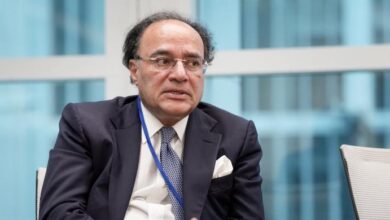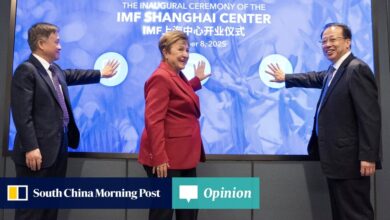On tackling inflation | Pakistan Today

When the State Bank of Pakistan (SBP) increased the policy rate to 22 percent– effective 27 March 2023– the CPI inflation rate was 35.4 percent. Since then, the inflation rate overall continued to fall, although slowly, but in February of this year it was above the policy rate of 22 percent– where the policy rate had stayed since it was raised last year to that level– whereby CPI stood at 23.1 percent.
Having said that, the reduction in policy rate came three months later, whereby on June 10, it was reduced, but by only 150 basis points to 20.5 percent, while inflation in May had substantially fallen to 11.8 percent. Although CPI inflation for June saw a little rise to 12.6 percent, but in July it fell to 11.1 percent, yet policy rate only saw one more downward revision, but only slightly, whereby on July 29, it was reduced to 19.5 percent. Hence, there still exists a yawning gap, between policy rate and inflation rate. of 8.4 percent.
While conventional economics called for having a slightly positive real interest rate– that is nominal interest rate to be slightly more than inflation rate– the current positive real interest rate stands at 8.4 percent. Even in the sense of conventional economics, this should be unacceptable, not to mention that especially in developing countries there is virtually no case for having a positive real interest rate, since traditionally in developing countries inflation is at least equal to fiscal phenomena, and not just mainly monetary phenomena.
Reining in overboard monetary austerity policy calls, in turn, for greater participation of government in monetary policy board of central banks, in general, in an overall effort to reduce the otherwise overboard independence of central banks, so that policy rate is not over-used to control inflation; a policy, which has generated unnecessarily high economic growth sacrifice, and enhanced debt distress; not to mention the rise in cost-push, and imported inflation that this policy induces
Moreover, the case of using mainly policy rate as the tool to control inflation has all the more lost its relevance in the wake of the covid-19 pandemic, and global supply shock.induced by geopolitical conflict In addition, in any case, even in developed countries the case for supply-side policies has gained more importance, both because of pandemic=related supply shock, but also due to the structural transformation of the global economy in the wake of mainly fast-unfolding existential threats, and digital re-orientation of the global economy due to quick advancements in artificial intelligence in recent years. Hence, it is important to raise the inflation target of 2-3 percent in advanced countries, and to not have positive real interest rates in developing countries, to control inflation.
Economics Nobel laureate, Joseph Stiglitz, in an interview to ‘ABC News (Australia)’ indicated in this regard ‘Well first let me say, where that number 2 to 3 percent come from. It was pulled out of the thin air. There was no scientific basis. It’s now become a convention that’s accepted. But, in fact, economic research argues that when the economy is going through a transformation, and we are going through a transformation– green economy, digital economy, post Covid-19 economy– you want to have probably a higher rate of target for your inflation. …I certainly think that there is no danger in having inflation of 4 or 5 percent, possibly even higher than that for a short period of time. You know, one doesn’t want to have runaway inflation, but there is very little evidence that going up to 4 or 5 percent will lead to runaway inflation.’
Similar thoughts were communicated by noted economist Berry Eichengreen, in his August 9, Financial Times (FT) published interview titled ‘Barry Eichengreen: ‘The Fed is operating in a fog of uncertainty’’, whereby he pointed out ‘The Fed is operating in a fog of uncertainty. Several of the financial anchors they relied on in the relatively placid period prior to Covid have been dragging subsequently. There’s debate about what the underlying equilibrium real interest rate is, for example, and about whether it has moved significantly because of changes in the structure of the economy and in the levels of indebtedness around the world. Therefore, there’s considerable uncertainty about the level of interest rates the Fed should be aiming at (the so-called neutral rate), for example.’
Reining in overboard monetary austerity policy calls, in turn, for greater participation of government in monetary policy board of central banks, in general, in an overall effort to reduce the otherwise overboard independence of central banks, so that policy rate is not over-used to control inflation; a policy, which has generated unnecessarily high economic growth sacrifice, and enhanced debt distress; not to mention the rise in cost-push, and imported inflation that this policy induces.
A recent Project Syndicate (PS) published article ‘The limits of central-bank independence’ indicated in this regard ‘Central-bank independence is often seen as a panacea to the type of high and persistent inflation that characterized the 1970s and early 1980s. To many, it looks like a free lunch: disinflation and long-term price stability without any adverse effects on growth and unemployment. But defenders of central-bank independence have almost certainly overestimated its role as a guarantor of low inflation. Consider a counterfactual: the Monetary Authority of Singapore has achieved an average inflation rate of almost 2% since its monetary-policy framework was introduced in the early 1980s. Few central banks can match this stellar record, and yet four government ministers sit on the MAS’s board, and there is little doubt that the Singaporean government can control monetary policy if it so wishes. Singapore has achieved consistently low, stable inflation without a robust regime of central-bank independence.’
Source link



